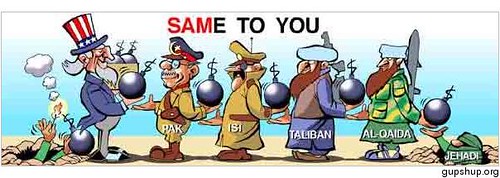Regarding the mastermind of the attacks, Sajid Mir:
Two years later, Mir and his victims are at the center of a wrenching national security dilemma confronting the Obama administration. The question, simply put, is whether the larger interests of the United States in maintaining good relations with Pakistan will permit Mir and other suspects to get away with one of the most devastating terrorist attacks in recent history.My answer is: Of course! The US government continues to pump in arms and money to the sponsors of Sajid Mir. These people also sponsor the Taliban who daily take the lives of American and other NATO soldiers.
All the talk of people being radicalized by poverty, by foreign occupation, by US foreign policy, etc., (e.g., Glenn Greenwald on salon.com) is well and good. What no one seems to be willing to confront is what to do about the state sponsorship of such.
Here are the articles:
1. On the trail of Pakistani terror group's elusive mastermind behind the Mumbai siege
2. An intricate plot unleashed in Mumbai, the West confronts a new threat
There is much commentary that can be given on these, including, e.g., the title of the second article.
Since the first article tells us:
Khan later told FBI agents that the Lashkar bosses asked him to conduct surveillance of an unnamed chemical plant in Maryland. The request shows that Lashkar was gathering intelligence on U.S. targets as early as 2001.this is not "the West confronts a new threat". This is the West - well, one of the top newspapers in the west - finally acknowledging the threat they've faced all along.
The first article makes this point repeatedly:
ProPublica's investigation leads to another disturbing revelation: Despite isolated voices of concern, for years the U.S. intelligence community was slow to focus on Lashkar and detect the extent of its determination to strike Western targets. Some officials admit that counterterrorism agencies grasped the dimensions of the threat only after the Mumbai attacks.and
"There should have been a recognition that Lashkar had the desire and the potential to attack the West and that we needed to get up to speed on this group," said Charles Faddis, a retired CIA chief of counterterrorist operations in South Asia and other hot spots. "It was a mistake to dismiss it as just a threat to India."and
"Lashkar is not just a tool of the ISI, but an ally of al-Qaeda that participates in its global jihad," said Jean-Louis Bruguiere, a French judge who investigated Mir. "Today Pakistan is the heart of the terrorist threat. And it may be too late to do anything about it."_______
The second article tells us:
ProPublica has tracked the rise of Lashkar through Mir's career as a holy warrior. It is a story of a militant group that used political clout and support from Pakistani security forces to develop global reach and formidable tradecraft, according to investigators and court documents. It is also a story of how, despite a series of warning signs, anti-terrorism agencies were caught off-guard when Lashkar escalated its war on the West with a 2008 attack on Mumbai that targeted Americans, Europeans and Jews as well as Indians.and
In October 2006, two years before the Mumbai attacks, Bruguiere issued an arrest warrant for Mir that was circulated worldwide by Interpol. There was no response from Pakistan.
A Paris court convicted Mir in absentia and sentenced him to 10 years in prison in 2007. Nonetheless, Bruguiere says most Western investigators he dealt with continued to view Lashkar as a regional actor confined to South Asia.
"For me it was a crucial case, a turning point," Bruguiere said, "because of what it revealed about the role played by Pakistani groups in the global jihad and about the role of the Pakistani security forces in terrorism. We had the impression that Mir was protected at the highest levels of the state."
IMO, we have to deal with the possibility that Sajid Mir was protected not jsut by the highest levels of the Pakistani state, but elsewhere as well.
In summer 2007, Bruguiere met at the White House with a top security adviser to President George W. Bush. The French judge shared his fears about Lashkar and his suspicion that Pakistani President Pervez Musharraf was playing a "double game." (Musharraf has asserted publicly that he was a staunch ally in the fight against terrorism.)
Bruguiere said the White House official, whom he declined to identify publicly, did not seem convinced.
IMO, if Kasab had not been captured alive at Mumbai, even this newspaper article would not exist; the Washington Post would still be singing Pakistan's song.

_____
Headley helped U.S. investigators overcome a basic problem they had run into on the Mumbai case. American agencies lacked data on Lashkar: photo books, organizational charts, profiles.
"The intelligence was very thin before Mumbai," said Rep. Gary L. Ackerman (D-N.Y.), whose House Foreign Affairs subcommittee held hearings on Lashkar this year.
Charles Faddis, a former CIA counterterrorism chief, contends the intelligence community did not dedicate enough resources to Lashkar.
"It's a classic problem in the U.S. intelligence community: failing to anticipate new threats and focusing completely on the one that already hit us," Faddis said.
A U.S. counterterrorism official disagreed, saying: "It's simply wrong to suggest that we've underestimated [Lashkar]."
It seems clear the government did underestimate Headley. A review this month by the director of national intelligence found that U.S. agencies had received six warnings about Headley from his wives and associates from October 2001 to December 2008. Yet federal agents didn't place him on a terrorist watch list or open a full investigation until July 2009, eight months after the Mumbai attacks. The office of the intelligence director has said nothing publicly about Headley's work as a U.S. informant.